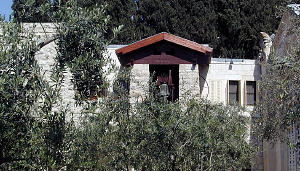 |
Garden of Gethsemane |
| After lunch we drove around the Old City to what used to
be in the Eastern part of Jerusalem in the years when the city was
divided. We were originally heading to the Mount of Olives first, but
traffic was gridlocked.
We stopped just up the road from the Basilica of the Agony, underneath the Old City walls and just above the tombs in the Valley of the Kings. |
|
| The Lonely Planet Guide Book published in September 1999 reads "Although badly tarnished by the weather, the golden domes of the White Russian Church are still one of Jerusalem's most attractive landmarks". In the intervening seven months the gold on the domes had been replaced, so by day and night the Church of Mary Magdalene dominates the hillside. It is now a convent and claims to contain a section of the Garden of Gethsemane. | |
| The current Basilica of the Agony, dating from 1924, is
the third church built on the same spot. The earliest was built in the
4th century.
The mosaic on the facade depicts Jesus taking on the troubles of the world. |
|
| Next to the Church is a garden of Olive trees, scientifically proved to be more than 2000 years old. This is the popularly accepted site of Gethsemane, the garden where Jesus was arrested. | |
| The interior of the church contains a large rock just
about above the floor level, upon which Jesus is believed to have prayed
and sweated blood on the night he was arrested.
The interior is dominated by a huge mosaic of Christ "in agony" above the main altar.
|
|
| After a long day of Hermann's extensive explanations of everything we saw, this sign came as something of a relief. | |
| There is not a great deal of flat land around. Coaches struggled to find somewhere to park and even the souvenir salesman needed to improvise. |
Last updated on June 06, 2000